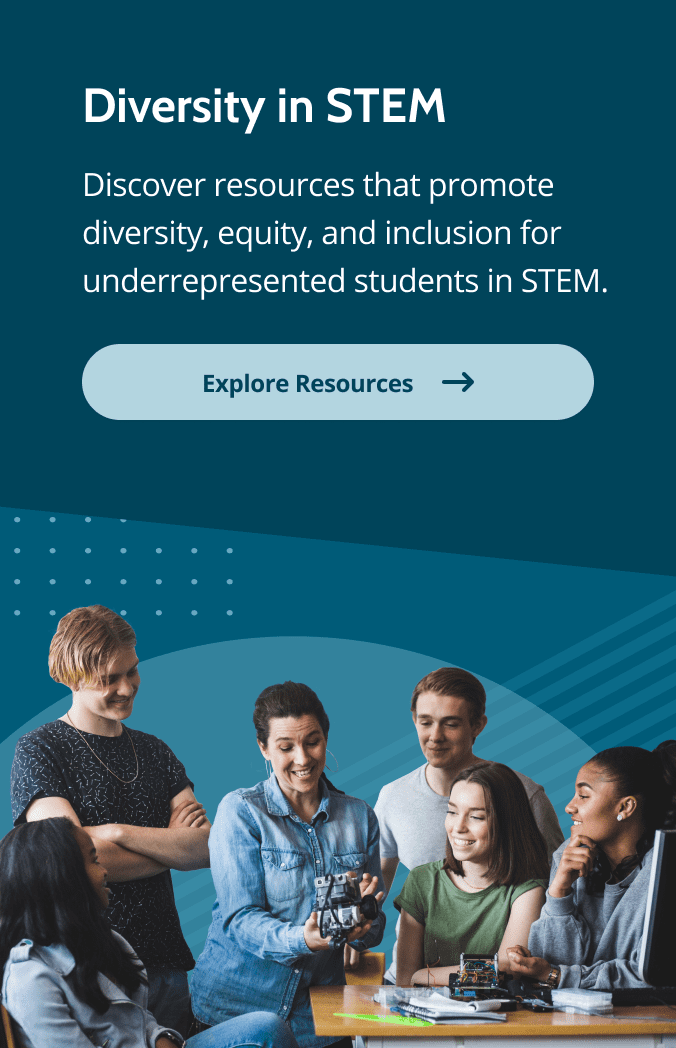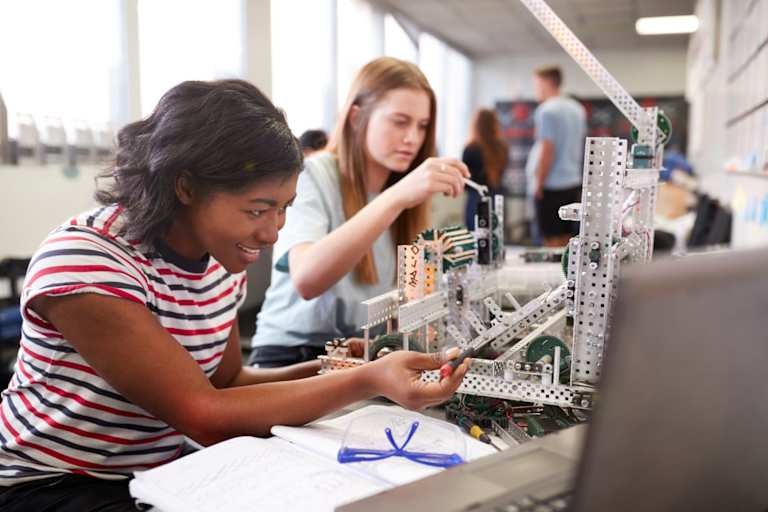Hispanics Are Key to Closing the Gap in the STEM Workforce
Ethnic and racial representation within science, technology, engineering, and math (STEM) fields is unbalanced, and Hispanic and Latino/a people experience some of the most noticeable disparities. This lack of diversity is driven in large part by inequities in educational support and opportunities.
A diverse workforce blends experiences, perspectives, and problem-solving strategies from many workers, which leads to more innovative and creative solutions that can help better the lives of people from all backgrounds. Welcoming more Hispanic and Latino/a workers in STEM fields can benefit communities around the world.
When it comes to improving diversity and inclusion in STEM, schools and STEM employers should be doing much more to help young Hispanics and Latino/as find and capitalize on opportunities.
The STEM Workforce by the Numbers
According to a Pew Research Center report from April 2021, Hispanic people make up 17% of the total workforce, but only 8% of workers in the STEM field. Comparatively, white workers make up 63% of the overall workforce and 67% of STEM workers. Furthermore, the average Hispanic STEM worker makes only 83% of the average white worker’s salary. These inequities demonstrate how STEM has routinely favored white workers while disfavoring Hispanic individuals.
While Hispanic representation in STEM has grown one percentage point since 2018, more needs to be done by higher education institutions and hiring managers to help fix this underrepresentation, but that will take time. According to the Society for Human Resource Management (SHRM), STEM jobs are the hardest to fill.
Why Are Hispanics and Latino/as Underrepresented in STEM Occupations?
Historically, Hispanic and Latino/a students have been underserved in STEM fields due to divergences in the education system. According to the Pew Research Center, in 2021, Hispanics earned 15% of all bachelor’s degrees in the U.S., but only 12% of STEM degrees. At the master’s level, they earned 11% of degrees overall, but only 9% of STEM degrees.
According to a 2020 Student Research Foundation (SRF) report, despite having similar STEM interests and aspirations as their non-Hispanic white and Asian peers, Hispanic high school students were less likely to have internet access and digital preparation. Due to this systemic lack of support, they also enrolled in fewer STEM classes, received lower grades, had lower confidence levels, and planned to attend community college (as opposed to a four-year school) at higher rates.
The numbers for Hispanic women in STEM look even worse. The SRF report found that Hispanic women represented 7% of the total workforce, but just 2% of STEM workers in 2018. Despite earning higher average grades than men, Hispanic women experienced the lowest levels of STEM confidence, and their interests and aspirations in STEM were lower than those of Hispanic men.
Among the many reasons for these divisions, differences in preparedness and socioeconomic status play a significant role. Hispanic students were more likely than their peers to attend under-resourced schools, come from lower-income households, and experience financial restrictions to higher education. Xenophobic and racist messaging and a lack of Hispanic visibility in STEM careers also dissuade young Hispanic and Latino/a students — especially women — from pursuing the discipline.
What Are Colleges and Universities Doing to Help Hispanic and Latino/a Students in STEM?
Across the country, colleges and universities — particularly Hispanic-serving institutions (HSIs) — encourage and support Hispanic and Latino/a students in their pursuit of STEM careers in various ways.
Grants
In 2018, the National Science Foundation provided a $10 million grant to six California State University campuses to help them focus on retaining and graduating more Hispanic and Latino/a students in STEM disciplines.
K-12 College Prep Programs
Some schools have developed preparatory programs to help young learners take the appropriate steps early on, like Maryville University’s Center for Access and Achievement (CA2). According to the center’s executive director, Steve Coxon, CA2 provides a free, Spanish-translated curriculum and online STEM courses to schools throughout the St. Louis region that educate students from historically excluded groups.
“We have created a preschool-to-profession pipeline in STEM. We work with students’ individual needs through our life coaching model and personalized learning environment,” said Coxon, who is also an associate professor of the online education program at Maryville. “For example, students majoring in cybersecurity provide monitoring for dozens of local schools, nonprofits, and small businesses in our Cyber Fusion Center under the guidance of our faculty — who also have major real-world cybersecurity experience.”
Undergraduate Resources
Many of the best colleges for Hispanic and Latino/a students offer specialized assistance for learners in underrepresented fields. For example, San Diego State University’s career services department hosts diversity initiatives and provides career development and preparation programs specifically for STEM careers.
The following colleges received grants to address the field’s inequities by providing access to resources, experiences, and opportunities for Hispanic and Latino/a learners.
- Lehman College: Pathways to Student STEM Success program
- Florida International University: STEM Transformation Institute
- University of California, Riverside: The Riverside Bridges to the Baccalaureate Program
- California State University, Long Beach: HSI STEM Sí Puedo project
How Can Colleges and Universities Prepare Hispanic and Latino/a Students for the STEM Workforce?
Colleges and universities can use various methods to help increase the number of Hispanic and Latino/a students pursuing careers in STEM. The following are possible initiatives that can take place at the grassroots level, as well as within colleges and universities, individual classrooms, and career services departments.
Grassroots efforts:
- Develop community outreach and digital literacy efforts.
- Run a speaker series to provide encouragement and increase visibility for Hispanic and Latino/a role models.
- Connect with local schools to identify and support promising young students who show an interest in STEM.
In the classroom:
- Incorporate culturally relevant education by bridging Hispanic, Latino/a, and STEM culture; critiquing power; and reflecting on evolving cultural practices.
- Focus on research, STEM skills, and practical applications.
- Guide students who show an aptitude or interest in the field toward opportunities.
At the institutional level:
- Provide specialized support services for Hispanic and Latino/a students.
- Establish fellowships, mentorship programs, and scholarships for Hispanic and Latino/a students.
- Partner with local organizations in the STEM field to provide internships and postgraduate opportunities.
Career services:
- Host STEM career workshops and job fairs.
- Provide networking opportunities with alumni for current students.
- Offer professional development programs for STEM graduates.
- Create reskilling programs for Hispanic and Latino/a community members.


Make an Impact in STEM
To make a positive impact on the STEM field and workforce, colleges and universities need to begin in their backyard. By developing support programs and pathways within their communities, institutions can help Hispanic and Latino/a students overcome systemic barriers and make careers in STEM more accessible.
Frequently Asked Questions About Careers in STEM
With Advice From:

Steve Coxon, Ph.D., is professor of education and executive director of the Center for Access and Achievement (CA2) at Maryville University. CA2 focuses on partnerships with schools and nonprofits to prepare teachers and precollegiate students for college and the careers of the future through STEM education. Steve conducts research on developing STEM talents, especially spatial ability, mathematics, and creativity, with a special focus on talent development in populations traditionally underrepresented in gifted and STEM education. He is the author of more than 50 publications, including the book “Serving Visual-Spatial Learners” and has given more than 100 presentations and workshops on these topics. Steve earned his Ph.D. from William & Mary in educational policy, planning, and leadership in gifted education. He was the 2010 recipient of the Joyce VanTassel-Baska Award for Excellence in Gifted Education and the 2020 recipient of the Laura Joyner Award from the Mensa Foundation.
Explore More College Resources

How Colleges Can Achieve Diversity in STEM
STEM fields are highly lucrative and in demand, but Black, brown, and female students face unique barriers to receiving a STEM education in college.

by Anne Dennon
Updated November 1, 2023

STEM Careers: Everything You Need to Know
Want to work with computers and technology? Or maybe science and math? Learn how to break into popular STEM careers today.

by Hannah Muniz
Updated July 30, 2024

